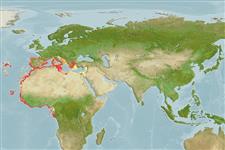>
Callionymiformes (Dragonets) >
Callionymidae (Dragonets)
Etymology: Synchiropus: Greek, syn, symphysis = grown together + Greek, cheir = hand + Greek, pous = foot (Ref. 45335).
Eponymy: In Greek mythology, Phaëton was the son of the sun god Helios. The name means ‘shining one’. The reason for applying this name to the dragonet was not explained. (Ref. 128868), visit book page.
More on author: Günther.
Environment: milieu / climate zone / depth range / distribution range
Écologie
marin démersal; profondeur 80 - 848 m (Ref. 56504). Subtropical; 45°N - 4°S, 32°W - 36°E
Eastern Atlantic: Portugal and the Azores to Gabon, including the Mediterranean.
Taille / Poids / Âge
Maturity: Lm ? range ? - ? cm
Max length : 18.0 cm TL mâle / non sexé; (Ref. 5968); 12.0 cm TL (female); common length : 12.0 cm TL mâle / non sexé; (Ref. 5968); common length :8 cm TL (female)
Depth range from 80-650 m (Ref. 06941) and from 302-848 m in the eastern Ionian Sea (Ref. 56504). Found on sand or mud bottoms. Territorial, males aggressive to each other. Feeds on small bottom invertebrates, mainly worms, snails and crustaceans. Eggs and larvae pelagic (Ref. 5968). Minimum depth reported from Ref. 26999.
Life cycle and mating behavior
Maturité | Reproduction | Frai | Œufs | Fécondité | Larves
Davis, W.P and R. Fricke, 1990. Callionymidae. p. 921-924. In J.C. Quero, J.C. Hureau, C. Karrer, A. Post and L. Saldanha (eds.) Check-list of the fishes of the eastern tropical Atlantic (CLOFETA). JNICT, Lisbon, SEI, Paris; and UNESCO, Paris. Vol. 2. (Ref. 6941)
Statut dans la liste rouge de l'IUCN (Ref. 130435: Version 2024-2)
Menace pour l'homme
Harmless
Utilisations par l'homme
Pêcheries: sans intérêt
Outils
Articles particuliers
Télécharger en XML
Sources Internet
Estimates based on models
Preferred temperature (Ref.
123201): 10.8 - 14.9, mean 13.8 °C (based on 127 cells).
Phylogenetic diversity index (Ref.
82804): PD
50 = 0.5000 [Uniqueness, from 0.5 = low to 2.0 = high].
Bayesian length-weight: a=0.00794 (0.00466 - 0.01353), b=2.78 (2.64 - 2.92), in cm total length, based on LWR estimates for this species & (Sub)family-body (Ref.
93245).
Niveau trophique (Ref.
69278): 3.4 ±0.45 se; based on food items.
Generation time: 7.0 ( na - na) years. Estimated as median ln(3)/K based on 2
growth studies.
Résilience (Ref.
120179): Milieu, temps minimum de doublement de population : 1,4 à 4,4 années (Preliminary K or Fecundity.).
Fishing Vulnerability (Ref.
59153): Low to moderate vulnerability (35 of 100).
Nutrients (Ref.
124155): Calcium = 81.6 [15.3, 237.6] mg/100g; Iron = 1.28 [0.46, 4.77] mg/100g; Protein = 3.63 [0.00, 7.34] %; Omega3 = 0.602 [0.257, 1.381] g/100g; Selenium = 24.5 [5.4, 70.2] μg/100g; VitaminA = 18.4 [6.5, 52.4] μg/100g; Zinc = 0.871 [0.436, 1.712] mg/100g (wet weight);
